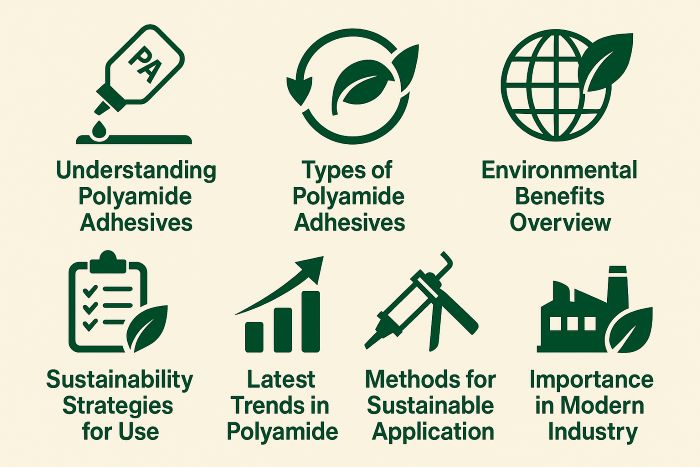
Understanding Polyamide Adhesives
Types of Polyamide Adhesives
Environmental Benefits Overview
Sustainability Strategies for Use
Latest Trends in Polyamide Use
Methods for Sustainable Application
Importance in Modern Industry
Frequently Asked Questions (FAQ)
Polyamide adhesives are increasingly recognized for both high performance and environmental compatibility. Derived in part from renewable resources, these adhesives contribute to reducing industrial carbon footprints. Their low VOC emissions and potential biodegradability make them ideal for manufacturers seeking eco-conscious bonding solutions. These adhesives meet technical demands while supporting long-term sustainability goals across industries.
Polyamide adhesives offer several ecological advantages that align with global sustainability goals:
Renewable origin: Certain formulations include content from plant-derived or recyclable inputs.
Low VOC emissions: Promote cleaner air and safer work environments.
Biodegradability: Contribute to reduced long-term ecological impact after disposal.
By incorporating these adhesives, manufacturers can align with environmental compliance standards while maintaining product integrity.
To enhance the eco-performance of polyamide adhesives, consider implementing the following:
Precision dispensing: Reduce overuse and material waste.
Renewable adhesive selection: Prioritize materials with verified bio-content or lower environmental burden.
Recycling initiatives: Reuse production waste and packaging wherever feasible.
Supplier alignment: Work with manufacturers who provide transparency in eco-certifications and material sourcing.
These strategies support greener production systems and help businesses meet internal and regulatory sustainability benchmarks.
Recent developments in polyamide adhesive technology reflect a strong shift toward eco-conscious innovation. Key trends include:
Biodegradable formulations for end-of-life material management
Heat-efficient hot melts to lower energy use
Increased adoption of bio-based inputs to reduce dependency on petrochemicals
These trends demonstrate how adhesives can evolve to meet both technical and environmental needs, fostering a future where bonding solutions support cleaner manufacturing.
Effective application of polyamide adhesives plays a crucial role in reducing environmental impact:
Automated precision systems (e.g., extrusion, slot die, spray) help minimize over-application.
Optimized settings (e.g., temperature, pressure) reduce energy consumption during bonding.
Consistent maintenance of application equipment reduces downtime and waste.
Material lifecycle analysis ensures each product’s contribution to eco-performance is well understood.
Through these practices, industries can ensure both adhesive efficiency and sustainability outcomes are achieved.
Polyamide adhesives have become a vital component in modern sustainable manufacturing due to their balance of performance and environmental responsibility. By offering strong, long-lasting bonds while minimizing harmful emissions and supporting renewable sourcing, these adhesives help companies:
Comply with tightening environmental regulations
Improve workplace safety
Enhance product lifecycle sustainability
They are particularly relevant in sectors such as automotive, electronics, filtration, and packaging, where both performance and eco-credentials are critical.
What are polyamide adhesives?
They are high-performance adhesives made from polyamide resins, often incorporating renewable or recyclable materials, known for strength, thermal resistance, and eco-friendly features.
What types of polyamide adhesives are available?
Options include thermoplastic (flexible), reactive (durable), and hot melt (fast-setting) types, each suited to specific applications and environmental goals.
How do polyamide adhesives benefit the environment?
They reduce environmental impact through low VOC emissions, potential biodegradability, and in some cases, renewable sourcing of raw materials.
What are examples of sustainable polyamide adhesives?
Sustainable variants include those that contain bio-based content, exhibit low emissions, and are optimized for energy-efficient application processes.
How can manufacturers optimize adhesive use sustainably?
By using advanced application systems, minimizing waste, selecting renewable materials, and incorporating recycling and lifecycle tracking into production.
What trends are shaping the polyamide adhesive market?
Eco-focused innovation is leading the way, with growing demand for biodegradable, energy-saving, and bio-derived adhesive technologies.
Why are these adhesives important in modern industry?
They enable high-performance bonding while meeting environmental regulations, helping industries transition to more responsible and sustainable production models.
What sustainability practices should be adopted with polyamide adhesives?
Use only the required volume through precision application, choose low-impact formulations, and integrate recycling and waste-reduction practices wherever possible.